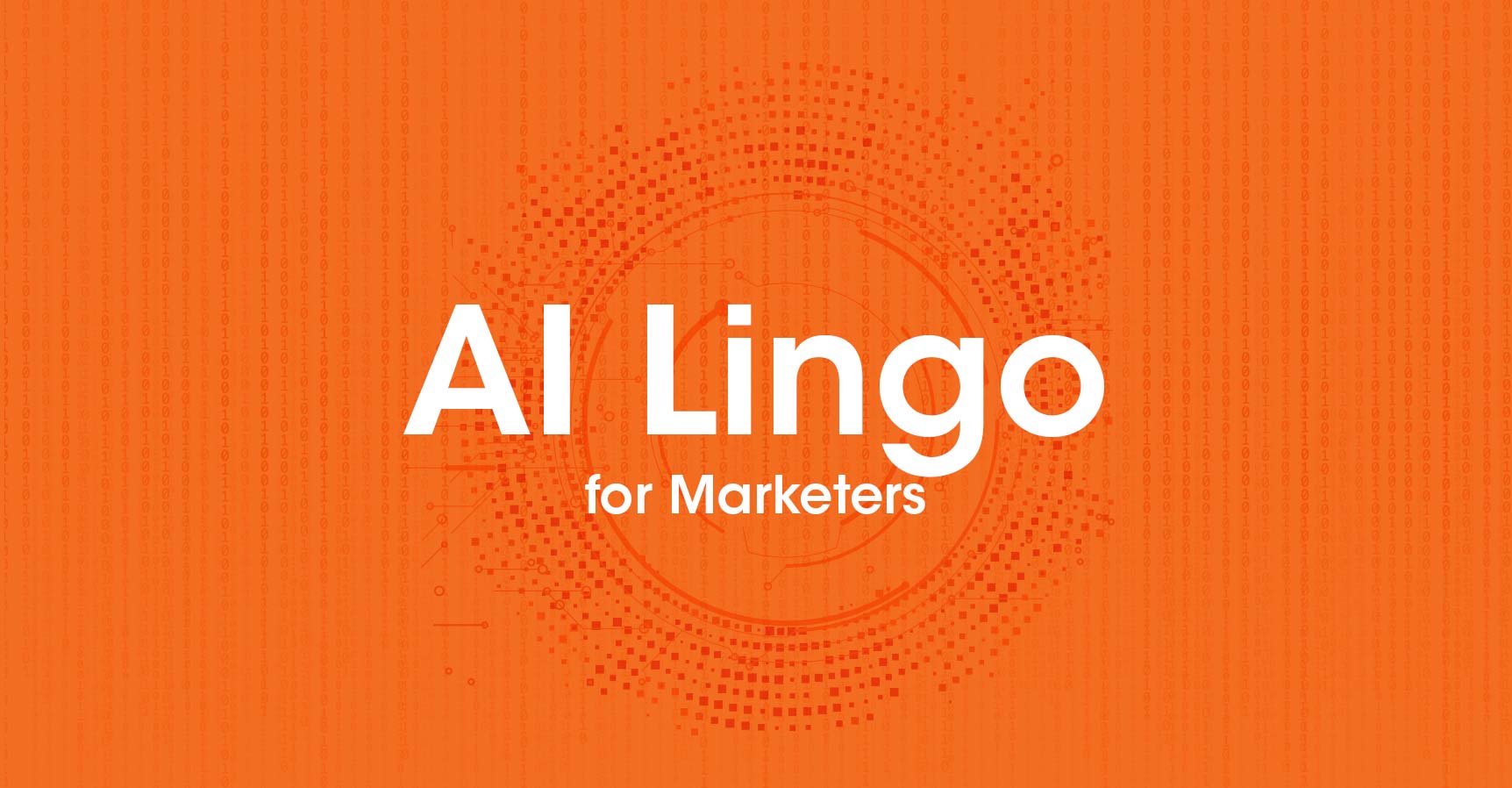AI Lingo for Marketers: A Jargon-Free Glossary Beyond the Buzzwords

We get it — diving into the world of AI can feel a bit like venturing into uncharted waters. The buzzwords, the algorithms, the sheer magic of what AI can do—it’s exciting, but overwhelming.
This glossary makes AI jargon less intimidating. It breaks down complex AI terms into clear, simple definitions covering core concepts like prompt engineering to conversational AI. And we’ll be updating it regularly as this space explodes with new terms.
Whether you’re new or experienced with AI, this glossary let’s you get up to speed on key terminology so you can strategically apply AI in your marketing role.
A-L M-Z AI Platforms for Marketers
A-L
AI (Artificial Intelligence) – The ability of a machine to imitate intelligent human behavior. In marketing, AI can be used for predictive analytics, personalization, content creation, and more.
AI Ad Targeting – Using AI and machine learning to optimize ad targeting and predict which consumers are most likely to convert.
AI-Supported Content Creation – Leveraging AI tools to automate content writing for things like social media posts, ad copy, landing pages, emails, etc.
Augmented Intelligence – When human and artificial intelligence work together to enhance cognitive performance. The strengths of humans and machines complement each other.
Bias: The assumptions and tendencies inherent in an AI system’s training data or algorithm that can lead to prejudiced or unfair results. AI models should be evaluated for bias before deployment.
Bots – An AI program that runs automated tasks and simulates human conversation. Marketers use bots for customer service, lead generation, and more.
Chain of Thought: The logical reasoning process an AI system uses to reach a conclusion or decision. Understanding the chain of thought behind AI decisions is important for transparency.
Chatbot: A software program designed to simulate conversational interactions with humans via text or voice. Chatbots utilize natural language processing to understand user inputs and respond appropriately.
Computer Vision – The ability of AI systems to identify, categorize, and understand visual elements from images and videos. Enables capabilities like image recognition and classification.
Conversational AI – The use of chatbots, voice assistants, and other tools that allow for natural two-way dialogue between humans and machines. Conversational AI can deliver personalized experiences at scale.
Conversational Marketing – Using chatbots and voice assistants to interact with customers and prospects in a natural, conversational way.
Conversion Rate Optimization – Using AI to continually test and improve landing pages in order to maximize conversion rates.
Customer Segmentation – Grouping customers into cohorts using machine learning techniques like clustering.
Deep Learning – A subset of machine learning using neural networks with multiple layers to swiftly learn complex data connections.
Dynamic Pricing – Continuously optimizing pricing for products and services using AI algorithms.
Fine-tuning – The process of refining a pre-trained model on a smaller, specific dataset. Enables models like ChatGPT to be more suitable for specific tasks or domains.
Foundation Model: A broad artificial intelligence model trained on diverse data to serve as a general-purpose starting point for more specialized AI applications.
GPT Architecture – A type of neural network architecture called the “Generative Pre-trained Transformer” used by OpenAI for models like ChatGPT. Known for its capabilities in understanding context and generating coherent text.
Lead Scoring – Assigning scores to leads using AI to determine sales-readiness based on past behaviors and interactions.
M-Z
Machine Learning – An application of AI that provides systems the ability to automatically learn and improve from experience without being explicitly programmed. Machine learning focuses on the development of computer programs that can teach themselves when exposed to new data.
Natural Language Generation (NLG) – The production of text by AI systems from computer-generated data and rules. NLG allows machines like chatbots to hold fluent conversations.
Natural Language Processing (NLP) – The ability of a computer program to understand, interpret, and analyze human language. NLP powers chatbots, voice search, and more. It’s what allows humans to communicate with machines using natural language.
Personalization – Using AI to deliver hyper-customized experiences, recommendations, and offers to each individual user.
Predictive Analytics – Using AI to uncover insights, trends, and predict future outcomes from data.
Private GPTs – Private GPTs are custom versions of the GPT model tailored for specific applications, industries, or users, with enhanced data privacy measures and not publicly available. These models may be adapted to specific domains, industries, or tasks to provide more tailored outputs, or may incorporate data privacy and security measures to protect sensitive information. Example: CustomGPT
Prompting – The process of providing input or instructions to a language model to obtain a desired output. In the context of ChatGPT and similar models, the prompt is the initial text or question provided to the model to guide its response.
Prompt Engineering – The art and science of crafting effective prompts to guide AI models, like ChatGPT, in producing desired outputs. It involves understanding the nuances of a model’s behavior and iteratively refining prompts to achieve better results.
Recommendation Engine – AI systems that learn from data and interactions to predict items or content that a specific user would prefer. Recommendation engines deliver hyper-personalized experiences.
Sentiment Analysis – Analyzing customer sentiment at scale to determine brand perception, monitor campaigns, and more.
Token – In the context of language models, a unit of text that the model reads. A token can be as short as one character or as long as one word.
Transformer Models – A type of deep learning model that has proven highly effective for natural language processing tasks. ChatGPT is based on a transformer architecture.
AI Platforms for Marketers
Claude 2: An AI assistant created by Anthropic to be helpful, harmless, and honest through dialogue with users.
ChatGPT – OpenAI’s language model designed for human-like text generation and interaction. Used in chatbots, content creation, and more.
Rosemary Brisco
AI Training Videos
AI Consulting and Training
Master today’s most effective productivity tools.
ToTheWeb ensures your route to capitalizing on the immense power of AI is fast and efficient. Our AI consulting and training programs will quickly enable your marketing team to adopt solutions to optimize operations and boost performance.
Learn about our generative AI and ChatGPT consulting and training programs


